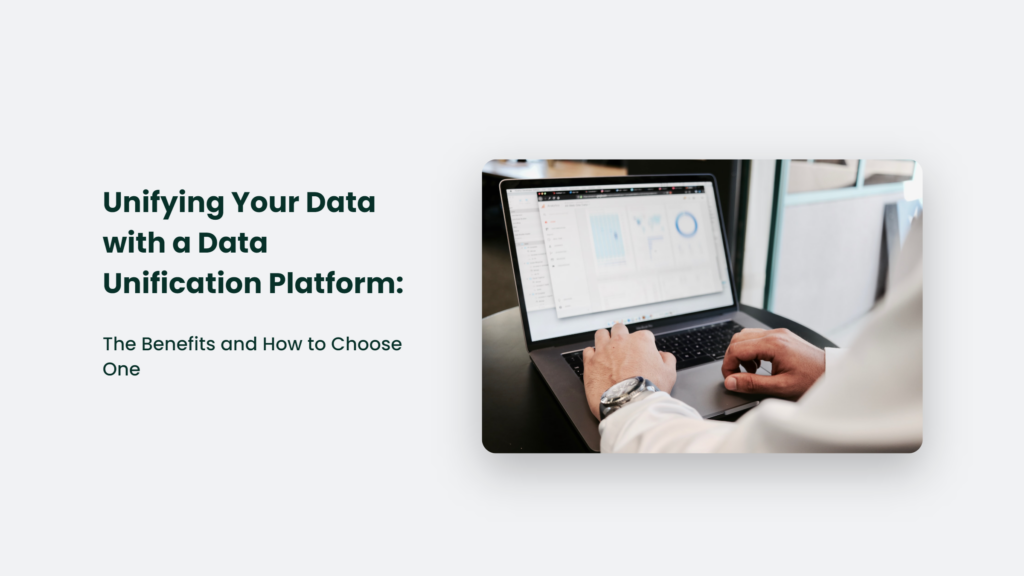In today’s digital age, businesses rely on data more than ever. However, bringing everything together and making sense of it all can be challenging with so many different data sources. That’s where a data unification platform comes in.

What is a Data Unification Platform?
A data unification platform is a software system that allows businesses to quickly and easily unify their data to gain better insights and make more informed decisions. Data unification is a process that combines data from multiple sources and formats into a single, unified view. It allows businesses to gain insights from multiple information streams by making it easier to analyze and interpret.
Why use a Data Unification Platform?
Using a unified platform aims to reduce the time it takes to clean, integrate, and analyze data. These platforms allow businesses to combine structured and unstructured data from various sources into one place. By consolidating this information, businesses can identify patterns, correlations, trends, anomalies, and outliers in their data more quickly than ever before.
Data unification platforms have become popular as businesses strive for greater efficiency in their operations. They can help identify areas where processes are inefficient or ineffective so that improvements can be made. Additionally, these systems allow for fast access to real-time information, which can result in improved decision-making capabilities.
Benefits of Data Unification Platforms:
There are many benefits that businesses can reap from using a data unification platform:
- Improved Decision-Making: By gathering data from multiple sources and organizing it into a unified format, businesses can gain better insights into their customer’s needs or preferences and make more informed decisions.
- Cost Savings: Data unification platforms allow businesses to save time and reduce costs by eliminating the need for manual processes such as data cleaning and integration, resulting in increased efficiency and lower operational expenses.
- Increased Analytical Power: These platforms allow businesses to quickly analyze and interpret their data, leading to better strategic decisions.
- Greater Accuracy: Data unification platforms use machine-learning algorithms to find patterns, correlations, trends and anomalies in the data, which can improve the accuracy of analytics results.
- Improved Customer Experience: By understanding customer behaviour, businesses can offer personalized experiences that improve customer satisfaction and loyalty.
How to Choose a Data Unification Platform
So, how do you choose a data unification platform for your business? Here are some key factors to consider:
- Integration Capabilities: Make sure your chosen platform can integrate with the data sources you need to bring together. It will ensure you can get a unified view of your data quickly and easily.
- Scalability: Also, consider the scalability of the platform. As your business grows, you’ll likely need to bring more data sources into your unified view. Make sure the platform you choose can accommodate this growth.
- User-Friendliness: The platform should also be user-friendly, so your team can get up and running quickly and easily. Look for a platform with a simple, intuitive interface and robust documentation and support.
- Data Security: Data security is critical, especially when dealing with sensitive or confidential information. Ensure your chosen platform has robust security features, such as encryption and access controls, to keep your data safe.
Best Platforms:
The best data unification analytics tools include Segment, Propellor, mParticle, Snowflake, Syncari, Hull, CIO, Voxco Intelligence and FirstHive.
These platforms use a combination of machine learning and human expertise to help businesses create unified customer profiles from integrated customer data. It helps them control costs and make their marketing more effective.
The process of data unification involves turning raw data from multiple sources into a structured format. It simplifies data analytics and can be used for further analysis.
The Bottom Line:
In conclusion, a data unification platform can bring numerous benefits to your business, from improved data quality to better decision-making and increased productivity. Just make sure to choose a platform that meets your needs and fits your existing technology stack well.




